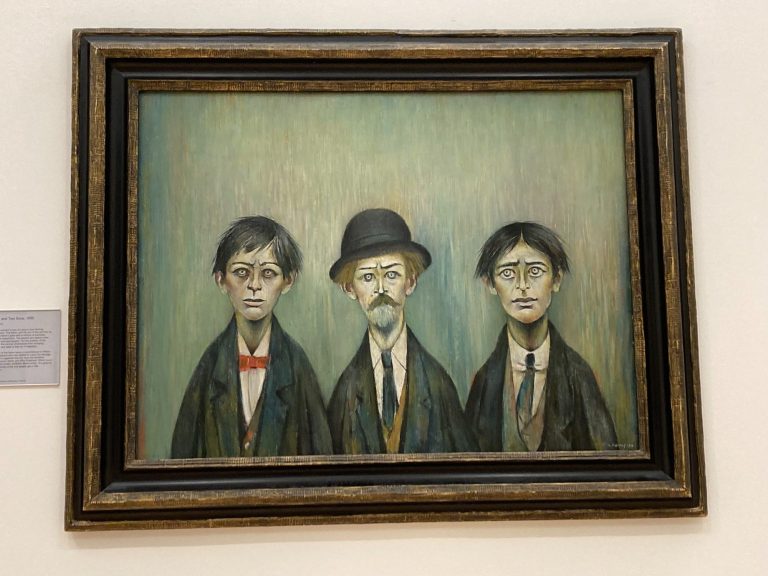Blog
A Liking for Lowry
My introduction to the art of Laurence Stephen Lowry
When I was young, my father (himself an artist who had trained in the 1950s at the Manchester School of Art), often used to take me to Salford Museum. Before our first visit there, he told me that he was going to show me some very strange paintings that would be like nothing I had ever seen before. In those days (the 1970s and 1980s), the gallery was a rather different place to the family-friendly space it is today. I remember it as being rather dark and Victorian, with displays of medical specimens in glass jars; ‘curiosities’ as they were euphemistically termed. There was a feeling of unease about the place and I was apprehensive about seeing the paintings. As my parents chatted brightly about the artist, I approached the pictures in their heavy, crumbly-looking frames. He was dead now, my father said. He’d lived with his mother, not that far from where we lived as a matter of fact. Yes, he was an eccentric. Yes he’d died alone. The paintings that loomed over my worried little face were called simply, 'Heads'. Immediately, a single thought struck me. He, the artist Lowry, had painted them to frighten us. He’d painted them to frighten me. They were not portraits, they were horrors. The faces were ghostly, their expressions blank. Eyes red, staring. These were paintings of haunted men, haunting. I couldn’t forget the ‘Heads’ and I couldn’t forget the way in which they were painted. The plain backgrounds were streaked with lines of colour, as though the brush had been violently pulled down the canvas. In and amongst the grey and blue downward strokes, were scratches of red, which to my young eyes seemed to represent blood. I found out much later that Lowry had said that the heads frightened him too.
While the heads seemed shocking, the artist’s landscapes offered next to no comfort either. Misshapen figures lurched through grey streets. Some figures had huge heads and lopsided faces. Others had arms too short and legs too long. Their faces were often cruel and mocking. The sky, milky white, was indifferent to the plight of disabled beggars and bullied children. Lowry’s paintings presented no balm to those wanting to believe that the working men and women of Northern England were salt-of-the-earth types who’d give you their last shilling. No. These baguette-footed factory drones had been rendered senseless by poverty and the clash of the loom. When not walking to or from a mill, they were drinking, fighting, falling over, gaping gormlessly at a barrel organ, or ambling pointlessly around an Easter fair. As the critic John Ruskin observed, “You must either make a tool of the creature, or a man of him. You cannot make both.” Lowry painted people who had been hollowed-out by hard labour and deprivation. Their heads are so full of the factory process that even when they are outside its walls, they cannot move except with a mechanical gait. They look substantial, with their black clogs and grimy caps, but they are ghosts in the landscape. Not ghosts in the machine, but ghosts of the machine. It has been said that Lowry viewed his subjects with a pitiless eye. I would agree. He is an unsentimental recorder of working-class life and, I believe, it is because he puts the realities of drudge and penury into these childlike landscapes from a palette of primary colours, that his paintings have such a sinister edge.
Many years after my first visits to Salford Museum, I decided to make a few master copies and Lowry was one of the masters I chose to learn from. It is well-documented that he worked with a limited palette, mainly Winsor & Newton’s Ivory Black, Flake White, Yellow Ochre, Prussian Blue, and Scarlet Vermillion. This knowledge is, of course, a gift to the dedicated copyist. By sticking with this palette, one can produce very good approximations of Lowry’s works. There’s quite a bit more to it than that, but the constant of the limited palette is a great help. In future posts I will explore Lowry’s technique in greater detail, but for now I will say that Lowry’s style, while appearing naive and unsophisticated to the mildly interested gallery goer, is actually far more complicated and harder to reproduce than some may think. By recreating some of his paintings I have certainly gained a greater understanding of his work and, despite my early misgivings, a liking for Lowry.

Latest Projects
As well as producing copies of Lowry’s most famous works, I have been inspired to create some Lowryesque characters. My favourite of these is the Sandwich Board Man. Recently I was commissioned by Salford Museum and Art Gallery to produce some postcards bearing the gallery’s name.
This year three Lowry-inspired Christmas cards, ‘Have a Very Lowry Christmas’, ‘Christmas Eve on Lowry Street’ and ‘Lowry’s Dogs at Christmas’ will be available to buy at Salford Museum and Art Gallery and also directly through this website.
Your art journey starts here
Refresh, refine, and redesign your space with Nicola Ward Tonkinson
Explore Nicola's collection of paintings and prints. Own a piece of original art today.
©Copyright. All rights reserved.
We need your consent to load the translations
We use a third-party service to translate the website content that may collect data about your activity. Please review the details in the privacy policy and accept the service to view the translations.


